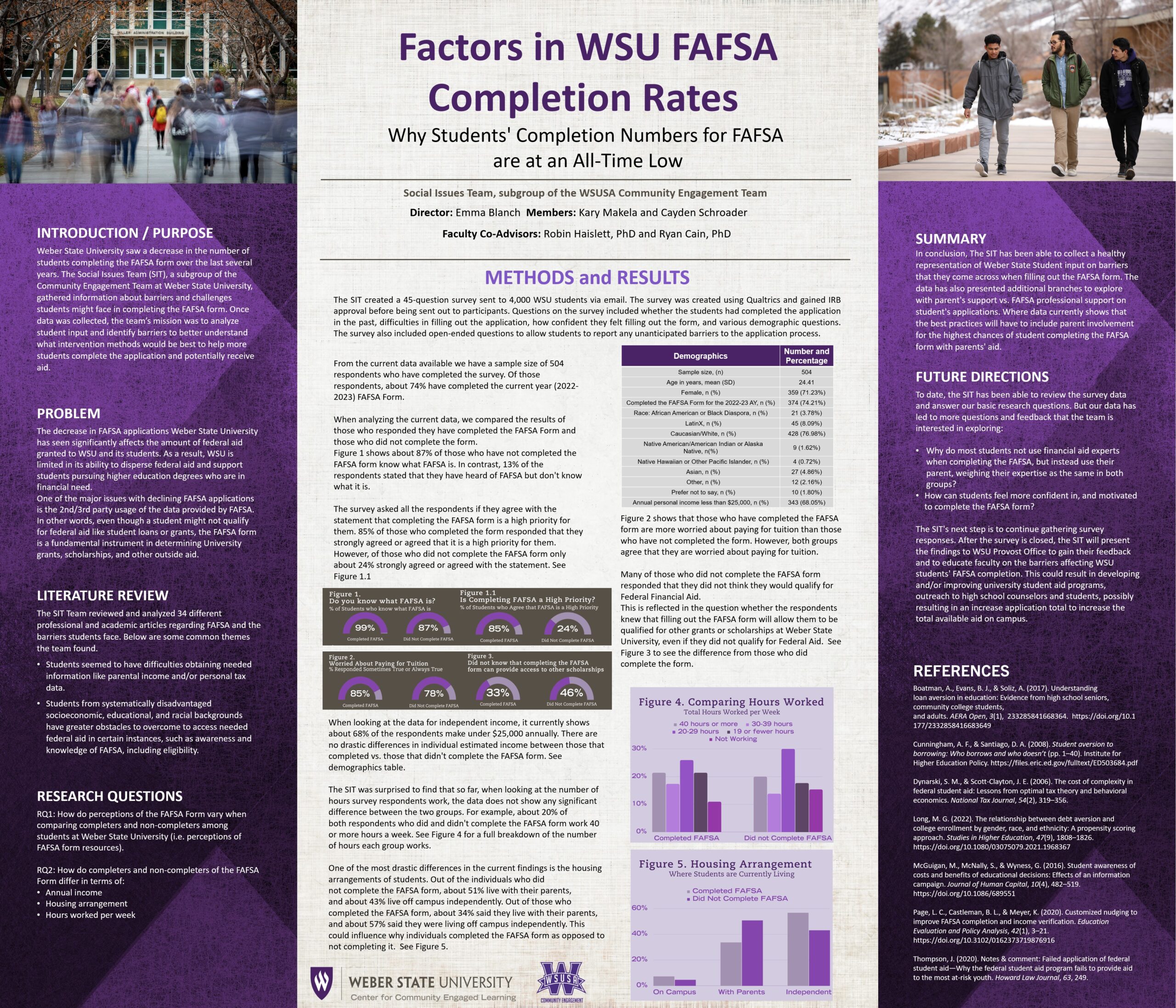Presenter Name: Cayden Schroader
Additional Presenters:
Emma Blanch (emmablanch@mail.weber.edu); Kary Makela (karymakela@mail.weber.edu)
Description
Weber State University found a decrease in the number of students completing the FAFSA form over the last several years. The Social Issues Team (SIT), a subgroup of the Community Engagement Team at Weber State University, took on the active gathering of information about barriers and challenges students might face in completing the FAFSA form.
According to research regarding FAFSA form completion, students from varying socioeconomic, education, and racial backgrounds have greater obstacles to overcome to access needed federal aid in certain instances (McGuigan et. al., 2016). Some of the more prominent concerns included students' awareness and knowledge of the program, the eligibility of the students applying (Long, 2022), debt aversion (Boatman et. al., 2017, Cunningham & Santiago), and parents' cooperation in providing financial information (Thompson, 2019). The SIT developed a ~45 question survey instrument to measure frequency of barriers to completing the FAFSA form identified by the literature review. The instrument also includes open-ended items to allow participants to report unanticipated barriers to completion. The survey asks questions regarding whether or not they have completed the FAFSA application in the past, difficulties in filling out the application, how confident they felt filling out the application, and various demographic questions that may be beneficial in discerning patterns and trends in the findings.
The SIT sent the draft survey to students and higher education experts on the WSU campus for evaluation to refine the instrument. Following survey refinement and IRB approval, the survey will be sent out to WSU students asking about potential barriers they may have when actively completing the FAFSA form. The SIT anticipates a total of 1,000 responses.
If findings follow previous research trends, then WSU could show a link between FAFSA form completion and the areas students need greater guidance in completing. A possible corresponding effort may result in more students having access to the aid they need to better fund their education. Also, an active program (Page, et. al., 2020) to target students of a specific demographic, which may result in a higher percentage of completion of the FAFSA form, and receive subsequent funding, at WSU.
According to research regarding FAFSA form completion, students from varying socioeconomic, education, and racial backgrounds have greater obstacles to overcome to access needed federal aid in certain instances (McGuigan et. al., 2016). Some of the more prominent concerns included students' awareness and knowledge of the program, the eligibility of the students applying (Long, 2022), debt aversion (Boatman et. al., 2017, Cunningham & Santiago), and parents' cooperation in providing financial information (Thompson, 2019). The SIT developed a ~45 question survey instrument to measure frequency of barriers to completing the FAFSA form identified by the literature review. The instrument also includes open-ended items to allow participants to report unanticipated barriers to completion. The survey asks questions regarding whether or not they have completed the FAFSA application in the past, difficulties in filling out the application, how confident they felt filling out the application, and various demographic questions that may be beneficial in discerning patterns and trends in the findings.
The SIT sent the draft survey to students and higher education experts on the WSU campus for evaluation to refine the instrument. Following survey refinement and IRB approval, the survey will be sent out to WSU students asking about potential barriers they may have when actively completing the FAFSA form. The SIT anticipates a total of 1,000 responses.
If findings follow previous research trends, then WSU could show a link between FAFSA form completion and the areas students need greater guidance in completing. A possible corresponding effort may result in more students having access to the aid they need to better fund their education. Also, an active program (Page, et. al., 2020) to target students of a specific demographic, which may result in a higher percentage of completion of the FAFSA form, and receive subsequent funding, at WSU.
University / Institution: Weber State University
Type: Poster
Format: In Person
Presentation #C75
SESSION C (1:45-3:15PM)
Area of Research: Education
Faculty Mentor: Ryan Cain and Robin Haislett

